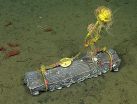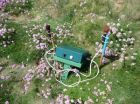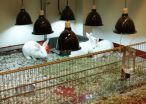(Press-News.org) PRINCETON, N.J.—Stressful upbringings can leave imprints on the genes of children as young as age 9, according to a study led by Princeton University and Pennsylvania State University researchers. Such chronic stress during youth leads to physiological weathering similar to aging.
A study of 40 9-year-old black boys, published in the Proceedings of the National Academy of Sciences, shows that those who grow up in disadvantaged environments have shorter telomeres — DNA sequences that generally shrink with age — than their advantaged peers. The researchers also report that boys with genetic sensitivities to their environment have shorter telomeres after experiencing stressful social environments than the telomeres of boys without the genetic sensitivities. These sensitivities are based on gene variants related to the serotonin and dopamine pathways — neurotransmitters essential for relaying information between the brain and body.
"African American children have really not yet been studied through this context," said co-author Sara McLanahan, Princeton's William S. Tod Professor of Sociology and Public Affairs. "Previous work has mostly focused on middle-class whites. Our study takes a different approach and really highlights the importance of early intervention to moderate disparities in social and educational opportunities."
The research team was led by Daniel Notterman, lead author and a visiting professor of molecular biology at Princeton and vice dean for research and graduate studies at the Pennsylvania State University's College of Medicine, and comprised of collaborators from Columbia University, the University of Michigan and the University of York in the United Kingdom. The team analyzed data collected by the Fragile Families and Child Wellbeing Study, a Princeton and Columbia study pioneered by McLanahan that includes 5,000 children born in 20 large American cities with populations over 200,000 people between 1998 and 2000. These children and their parents, who come from a wide range of social backgrounds, were interviewed at regular intervals between the child's birth and age 9. Saliva DNA samples were collected when the children were 9 years old.
The researchers wanted to focus on African American boys because past studies have shown that boys may be more sensitive to their environment. They restricted their sample to 40 boys who participated in the Fragile Families study and met the following criteria: they had provided saliva samples at age 9; their mothers self-identified as black or African American; and complete information was provided about their social environments. Of the sample, half of the boys were raised in disadvantaged environments, which the researchers characterized by such factors as a low household income, low maternal education, an unstable family structure and harsh parenting.
To measure telomere length, the researchers analyzed the saliva DNA provided by the boys. These telomeres, which live at the end of each chromosome, protect the ends from damage and vary in length by person, shrinking with age. Through their analysis, the researchers found that living in a disadvantaged environment was associated with 19 percent shorter telomeres by age 9. For boys predisposed to being sensitive to their environment, this negative association was even stronger.
"Our report is the first to examine the interactions between genes and social environments using telomeres as a biomarker," Notterman said. "We also demonstrate the utility of using saliva DNA to measure children's telomere length. This is important because most telomere research uses blood, which is much more difficult to collect than saliva. Using saliva is easier and less expensive, allowing researchers to collect telomere samples at various points in time to see how social environment may be affecting DNA."
Arline Geronimus, a professor at the University of Michigan who studies population health but was not involved in the study, said this work adds to the growing body of research related to the role of chronic stress in health inequalities, especially among the poor. Geronimus, a pioneer in research on physiological weathering, said she was particularly struck by how quickly the effects of chronic stress can be seen.
"I think it's very striking that these findings are in children at age 9, because you are talking about accelerated aging or stress-mediated wear and tear on your body, which make you more vulnerable to all kinds of illnesses and diseases. To say that you can see this by 9 years old is a very strong statement," Geronimus said.
INFORMATION:
In addition to McLanahan and Notterman, co-authors of the paper include Arthur Berg and Susan Rutherford from Penn State's College of Medicine, Jeanne Brooks-Gunn and Irwin Garfinkel from Columbia University, John Hobcraft from the University of York and Colter Mitchell from the University of Michigan.
The paper, "Social Disadvantage, Genetic Sensitivity and Children's Telomere Length," was published online April 7 in the Proceedings of the National Academy of Sciences. Funding for the study was provided by the Eunice Kennedy Shriver National Institute of Child Health and Human Development and the Penn State Clinical and Translational Science Institute.
Michael Hotchkiss contributed to this report.
Stressful environments genetically affect African-American boys
2014-04-09
ELSE PRESS RELEASES FROM THIS DATE:
Bone marrow stem cells show promise in stroke treatment, UCI team finds
2014-04-09
Irvine, Calif., April 9, 2014 — Stem cells culled from bone marrow may prove beneficial in stroke recovery, scientists at UC Irvine's Sue & Bill Gross Stem Cell Research Center have learned.
In an analysis of published research, neurologist Dr. Steven Cramer and biomedical engineer Weian Zhao identified 46 studies that examined the use of mesenchymal stromal cells – a type of multipotent adult stem cells mostly processed from bone marrow – in animal models of stroke. They found MSCs to be significantly better than control therapy in 44 of the studies.
Importantly, the ...
See what a child will look like using automated age-progression software
2014-04-09
It's a guessing game parents like to ponder: What will my child look like when she grows up? A computer could now answer the question in less than a minute.
University of Washington researchers have developed software that automatically generates images of a young child's face as it ages through a lifetime. The technique is the first fully automated approach for aging babies to adults that works with variable lighting, expressions and poses.
"Aging photos of very young children from a single photo is considered the most difficult of all scenarios, so we wanted to focus ...
Sunken logs create new worlds for seafloor animals
2014-04-09
MOSS LANDING, CA — When it comes to food, most of the deep sea is a desert. Many seafloor animals feed on marine snow—the organic remnants of algae and animals that live in the sunlit surface waters, far above. However, marine snow only falls as a light dusting and doesn't have much nutritional value. Thus, any other sources of food that reach the deep sea provide a temporary feast. Even bits of dead wood, waterlogged enough to sink, can support thriving communities of specialized animals. A new paper by biologists at the National Evolutionary Synthesis Center and the Monterey ...
Scientists reconstruct ancient impact that dwarfs dinosaur-extinction blast
2014-04-09
WASHINGTON, D.C. -- Picture this: A massive asteroid almost as wide as Rhode Island and about three to five times larger than the rock thought to have wiped out the dinosaurs slams into Earth. The collision punches a crater into the planet's crust that's nearly 500 kilometers (about 300 miles) across: greater than the distance from Washington, D.C. to New York City, and up to two and a half times larger in diameter than the hole formed by the dinosaur-killing asteroid. Seismic waves bigger than any recorded earthquakes shake the planet for about half an hour at any one ...
Counting the invisible by sound -- a new approach to estimate seabird populations
2014-04-09
AUDIO:
This is a typical one minute recording of an active Cory's Shearwater colony on the island of Corvo in the North Atlantic Ocean, June 2011.
Click here for more information.
Seabirds nest in places that are inaccessible for most humans - vertical cliffs and remote islands surrounded by raging waves. Worse still, many seabirds lay their eggs in burrows or cavities where they are protected from inclement weather and invisible for researchers. Hidden under rocks or in burrows ...
Rabbits kept indoors could be vitamin D deficient
2014-04-09
CHAMPAIGN, Ill. — Rabbits that remain indoors may suffer from a lack of vitamin D, researchers report in a new study. In rabbits kept as pets or used in laboratory studies, the deficiency could lead to dental problems, undermine their cardiovascular health, weaken their immune systems and skew scientific findings.
The study found that regular exposure to artificial ultraviolet B light for two weeks doubled rabbits' serum vitamin D levels – an increase not seen in animals raised in artificial light lacking UVB radiation. Future studies will seek to determine optimal levels ...
Recycling astronaut urine for energy and drinking water
2014-04-09
On the less glamorous side of space exploration, there's the more practical problem of waste — in particular, what to do with astronaut pee. But rather than ejecting it into space, scientists are developing a new technique that can turn this waste burden into a boon by converting it into fuel and much-needed drinking water. Their report, which could also inspire new ways to treat municipal wastewater, appears in the journal ACS Sustainable Chemistry & Engineering.
Eduardo Nicolau, Carlos R. Cabrera and colleagues point out that human waste on long-term journeys into ...
Can animals really help people in hospitals, aged care?
2014-04-09
While many people have an opinion on whether animals can help to improve wellbeing and care for patients in hospitals, does anyone really know whether there are benefits both for the patients and the animals themselves?
Not according to a team of researchers from the University of Adelaide, which has conducted a worldwide review of all studies looking at the impact of "animal interventions" in healthcare settings for children.
The researchers, from the University's School of Psychology and School of Animal and Veterinary Sciences, have found that despite theories emerging ...
NASA satellite sees Tropical Depression Peipah crawling toward Philippines
2014-04-09
NASA-NOAA's Suomi NPP satellite passed over the remnants of Tropical Depression Peipah on April 9 as the storm slowly approached the Philippines from the east. According to the Joint Typhoon Warning Center, Peipah is now not expected to make landfall in eastern Visayas until April 12.
The Visible Infrared Imaging Radiometer Suite or VIIRS instrument aboard Suomi NPP captured a visible, high-resolution image of the storm as it continued moving through the Philippine Sea. The storm appeared disorganized in the image, and the center was difficult to pinpoint on the visible ...
Promising agents burst through 'superbug' defenses to fight antibiotic resistance
2014-04-09
In the fight against "superbugs," scientists have discovered a class of agents that can make some of the most notorious strains vulnerable to the same antibiotics that they once handily shrugged off. The report on the promising agents called metallopolymers appears in the Journal of the American Chemical Society.
Chuanbing Tang and colleagues note that the antibiotic-resistant bacteria known as MRSA (methicillin-resistant Staphylococcus aureus) is responsible for a significant fraction of the infections that patients acquire in hospitals. According to the Centers for ...







